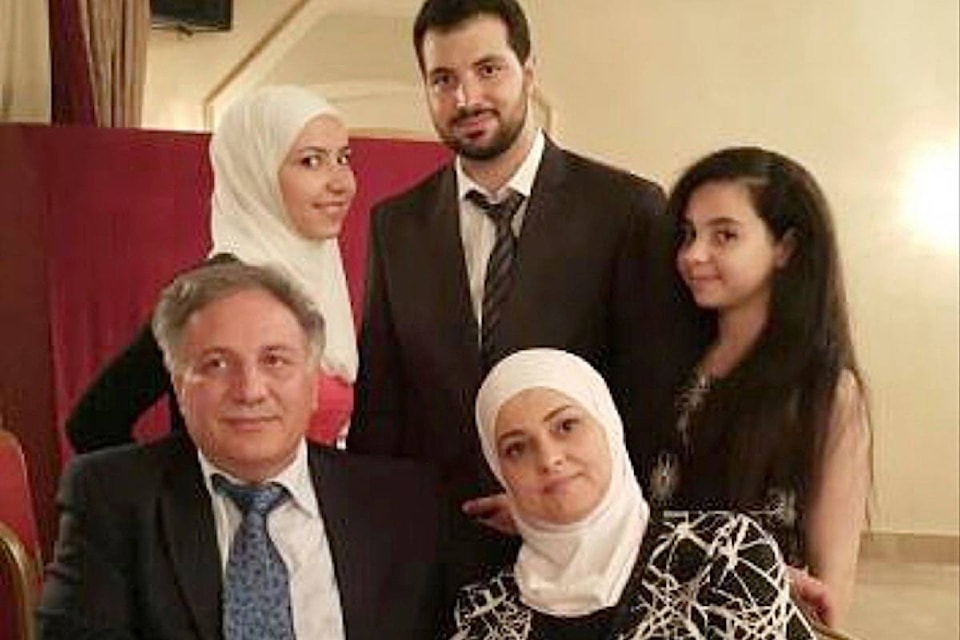All Hanadi Albarazanji wants is to reunite her family.
The White Rock resident last saw two of her three children in person five years ago, just before she fled war-torn Syria with her youngest daughter, Juman, to start a new life in Canada.
READ MORE: Syrian refugees embrace new ‘mother country’
READ MORE: Syria marks 7 years of war; thousands leave besieged enclave
The family didn’t have enough money for everyone to leave together, and as they were already adults, the older siblings – son Kenan, now 27, and daughter Yaman, 24 – also didn’t qualify as dependents under the same immigration application, she said.
But arriving here, Albarazanji, who was sponsored by her aunt, had hoped their steps to a fresh start would be similar to her own: a sponsor would be found and the process of relocating would unfold.
However, while her husband Emad was able to join her and their daughter in Canada, “dramatic” changes – including the closure of Turkey, Lebanon and Jordan borders to Syrians, and the United Nations Refugee Agency (UNHCR) no longer automatically issuing refugee status to Syrians if they are able to leave – not to mention pandemic-related delays – have left Albarazanji wondering if she’ll ever see her eldest children face-to-face again.
“My kids are essentially stuck in Syria and we have little to no chance of having our family be together in the foreseeable future,” Albarazanji said.
“When I see people talking (about) how much they are sad because the holidays and … Christmas and they can’t be together (because of the pandemic)… I feel like maybe next year you will meet them. But I can’t.
“I’m very scared that I’ll die and I won’t see them.”
Immigration consultant Amr Shehata said Albarazanji’s situation highlights a crack in the “one-year window application” process through which newly landed refugees can reunite with their immediate family members who are not yet in Canada: it only applies to spouses and dependent children.
On top of that, a refugee is defined as someone who has left their home country out of fear and availed themselves of the protection of the Canadian government, Shehata said.
“Which means they cannot go back to their home country while that regime is still there,” he continued. “At the same time, these two members of the family… are in Syria. They fall within that crack of one-year window, into nowhere.”
Kenan and Yaman also cannot be privately sponsored as refugees because they are still in Syria, he said – a problem that is difficult to rectify with borders of the tangent countries closed.
“The only other place is Iraq,” Shehata said. “So it will be… into the fire if you went from Syria to Iraq. Doesn’t really make any sense.”
READ MORE: Canada relocating some troops from Iraq to Kuwait due to safety concerns: Vance
Albarazanji, who was raised in the United Arab Emirates, said she is becoming increasingly distressed by the situation. Since arriving in Canada, she has “joined all the opportunities I had” in an effort to become part of the community, even volunteering with the non-profit MOSAIC organization. It was all “to have a good life with my kids,” she said.
“Now, everything I’ve done, I feel it is worthless. I can’t get my kids here, and they are very good kids. I know they will be a good fit here in Canada.”
Albarazanji worries her humanitarian and compassion application could take “another four or five years, if it works,” and Shehata confirmed there are no guarantees.
“It’s totally discretionary, the officer may accept, may not accept,” he said.
He noted that Canada has created temporary policies in the past to assist immigrants in reuniting with their families, and pointed to government’s Caring for Children Program – which ended in June 2019 – as one example. It created a pathway to permanent residence for women who came from a visa-required country for home-care work, he said.
“A lot of people in the profession knew the stress and the struggle that these ladies had,” Shehata said. “They left their home, they left their kids and they came to Canada to take care of our kids, and after that, there was no clear hope for them.
“But now, there is kind of a policy, a kind of program that allowing even if you didn’t disclose a family member, you can disclose them now and they can still be sponsored.
“There are similar cases where the government was responsive and supportive, let’s put it like that.
“Maybe Hanadi is one example, but I bet there are thousands of these families – a mother that really cannot do anything for their kids.”
If the government did do something similar to the Caring for Children Program, “this would be a new community,” he said.
Stories like Albarazanji’s are heartbreaking, he added.
“She has been waiting for a long time. Most painful part, she doesn’t know for how long she should be waiting, and even if she waited for that time, what would happen next.
“She cannot see a light by the end of the tunnel, as simple as that.”
tholmes@peacearchnews.com
Like us on Facebook and follow us on Twitter
